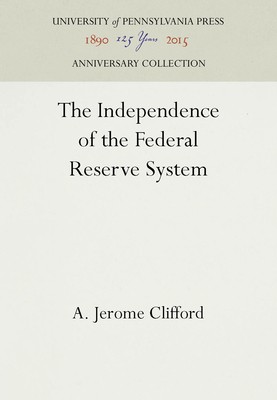
- We will send in 10–14 business days.
- Author: A Jerome Clifford
- Publisher: University of Pennsylvania Press Anniversary Collection
- ISBN-10: 0812273885
- ISBN-13: 9780812273885
- Format: 15.6 x 23.4 x 2.4 cm, hardcover
- Language: English
- SAVE -10% with code: EXTRA
Reviews
Description
The Federal Reserve Act became law on December 23, 1913. The need for the new monetary system for which this law provided was traceable to the frequently stated causal connection between crises and failure in the banking and currency system and crises and failure in commerce, industry, and agriculture. The supporters of the law argued that the continued prosperity and growth of the nation demanded that monetary malfunctions be cured.
The powers and responsibilities given to the new system were enveloped in structural arrangements designed to assure the organization itself as well as the nation that there would be competent, adequate, and independent authority to provide for a more efficient monetary system. Although unique, the solution was not simple in either structure or operation, for besides protecting itself from the dangers of government or private banker domination, the Federal Reserve System had to win and keep the help and cooperation of this same government and these same private banks. The System maintained its independence in two ways. First, the Federal Reserve System found its fundamental meaning in the governmental function delegated to it by Congress--the formation and execution of credit and monetary policy for public purposes. Yet it was set apart from the ordinary legislative and executive departments of the government. Second, the System worked to achieve its purposes by acting through and with the cooperation of the nation's private financial interests. Yet it was separate from those interests. The Federal Reserve System was designed to cooperate and still be independent. How it promoted this harmony, and yet avoided domination was its glory and its cross. It is of the history of this achievement that this book tells.EXTRA 10 % discount with code: EXTRA
The promotion ends in 16d.16:17:04
The discount code is valid when purchasing from 10 €. Discounts do not stack.
- Author: A Jerome Clifford
- Publisher: University of Pennsylvania Press Anniversary Collection
- ISBN-10: 0812273885
- ISBN-13: 9780812273885
- Format: 15.6 x 23.4 x 2.4 cm, hardcover
- Language: English English
The Federal Reserve Act became law on December 23, 1913. The need for the new monetary system for which this law provided was traceable to the frequently stated causal connection between crises and failure in the banking and currency system and crises and failure in commerce, industry, and agriculture. The supporters of the law argued that the continued prosperity and growth of the nation demanded that monetary malfunctions be cured.
The powers and responsibilities given to the new system were enveloped in structural arrangements designed to assure the organization itself as well as the nation that there would be competent, adequate, and independent authority to provide for a more efficient monetary system. Although unique, the solution was not simple in either structure or operation, for besides protecting itself from the dangers of government or private banker domination, the Federal Reserve System had to win and keep the help and cooperation of this same government and these same private banks. The System maintained its independence in two ways. First, the Federal Reserve System found its fundamental meaning in the governmental function delegated to it by Congress--the formation and execution of credit and monetary policy for public purposes. Yet it was set apart from the ordinary legislative and executive departments of the government. Second, the System worked to achieve its purposes by acting through and with the cooperation of the nation's private financial interests. Yet it was separate from those interests. The Federal Reserve System was designed to cooperate and still be independent. How it promoted this harmony, and yet avoided domination was its glory and its cross. It is of the history of this achievement that this book tells.

Reviews